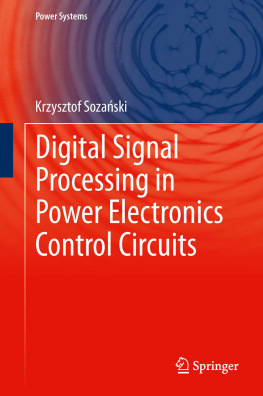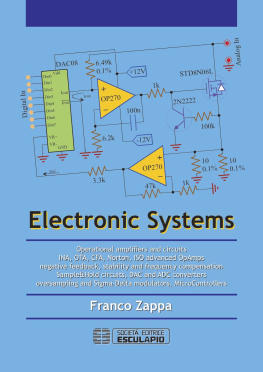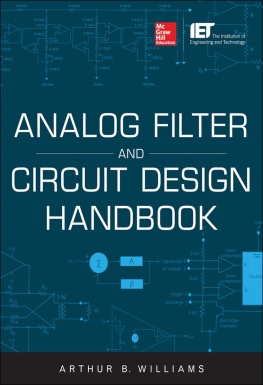Anand Udupa - Zen of Analog Circuit Design
Here you can read online Anand Udupa - Zen of Analog Circuit Design full text of the book (entire story) in english for free. Download pdf and epub, get meaning, cover and reviews about this ebook. year: 2015, genre: Home and family. Description of the work, (preface) as well as reviews are available. Best literature library LitArk.com created for fans of good reading and offers a wide selection of genres:
Romance novel
Science fiction
Adventure
Detective
Science
History
Home and family
Prose
Art
Politics
Computer
Non-fiction
Religion
Business
Children
Humor
Choose a favorite category and find really read worthwhile books. Enjoy immersion in the world of imagination, feel the emotions of the characters or learn something new for yourself, make an fascinating discovery.

- Book:Zen of Analog Circuit Design
- Author:
- Genre:
- Year:2015
- Rating:4 / 5
- Favourites:Add to favourites
- Your mark:
Zen of Analog Circuit Design: summary, description and annotation
We offer to read an annotation, description, summary or preface (depends on what the author of the book "Zen of Analog Circuit Design" wrote himself). If you haven't found the necessary information about the book — write in the comments, we will try to find it.
RECENTLY UPDATED WITH NEW CONTENT
From 2011 till 2013, I taught a course titled Analog Design for all which covered concepts starting with MOS transistors and progressed till the design of two-stage amplifiers. The course introduced concepts in a manner that led the student to the synthesis of new circuits, not merely their analysis. But I still felt that there was a more intuitive way to introduce Analog Circuit Design, one that would bring out the beauty of the subject so that the student could stop and smell the roses.
But why a Zen of Analog?
Because the foundational concepts in Analog closely mirror human relationships! The purpose of this book is to take a simplified and intuitive path to unlock some profound secrets of Analog. The protagonist of this book is Ang-Lao, a medieval monk who brings his insights into the Analog world to solve the challenges in human relationships.
The book addresses a problem statement that much of Analog Circuit Design tries to solve - how do you realize an ideal buffer? It starts with the simple concepts of voltage sources and current sources. From the I-V curve of the MOS transistor, we see how it behaves much like a Voltage controlled current source (VCCS). The inherent challenge in getting even a simple two-transistor circuit to work is the conflict arising from having two such current source-like elements in series. The digital inverter is shown to be one such circuit that can function like an analog amplifier, albeit over a narrow range of input voltage. The effect of loading on such a circuit is illustrated graphically and is shown as an added challenge in getting it to work in an analog manner.
Having understood the complications involved, we see how through the strikingly simple but immensely powerful concept of feedback, one of the two transistors can be modified subtly to make it behave like a voltage source. In that process, we realize our first approximation to an ideal analog buffer. We then see how manifestations of the same concept leads us to the synthesis of a whole bunch of two transistor circuits - source followers, common source amplifiers with gm-load and with diode-connected load, and differential amplifiers . The concepts used in synthesis of such elegant circuits are also extended to the analysis of much more complex circuits, for example, a Voltage to Current (V2I) conversion circuit. We introduce the concept of small signal parameters, gm, gds, showing the calculations for the gain and output impedance of our circuits, and quantifying how good each of our buffers really are.
The narrative switches between concepts of Electronics and the story of Aman-Ra, an engineer from Medieval Egypt. Struggling with his relationships, his guiding light is Ang-Lao, who teaches him the secret to happy relationships.
For some, this book will signal the end of the fear of Analog. For others, it will be the start of a love story.
Concepts covered
oI-V characteristics of Voltage & Current sources
oIdeal & non-ideal sources
oControlled sources
oActive and passive elements
oI-V characteristics of a MOSFET
oMOS transistor as a Voltage controlled current source
oDigital inverter as Analog amplifier
oOperating point
oCommon source (CS) amplifier
oEffect of loading on a CS amplifier
oFeedback
oHow can you make a MOSFET behave like a voltage source?
oSynthesis of a CS amplifier with diode-connected load
oAnalysis of a V2I circuit including an introduction to current mirror
oSynthesis of CS amplifier with gm-load
oSynthesis of source follower circuit
oSmall signal parameters: gm, gds
oSmall-signal gain and output impedance
oSynthesis of a differential amplifier
oSynthesis of an Operational amplifier
oRealizing the buffer using the Operational Amplifier
Anand Udupa: author's other books
Who wrote Zen of Analog Circuit Design? Find out the surname, the name of the author of the book and a list of all author's works by series.


















